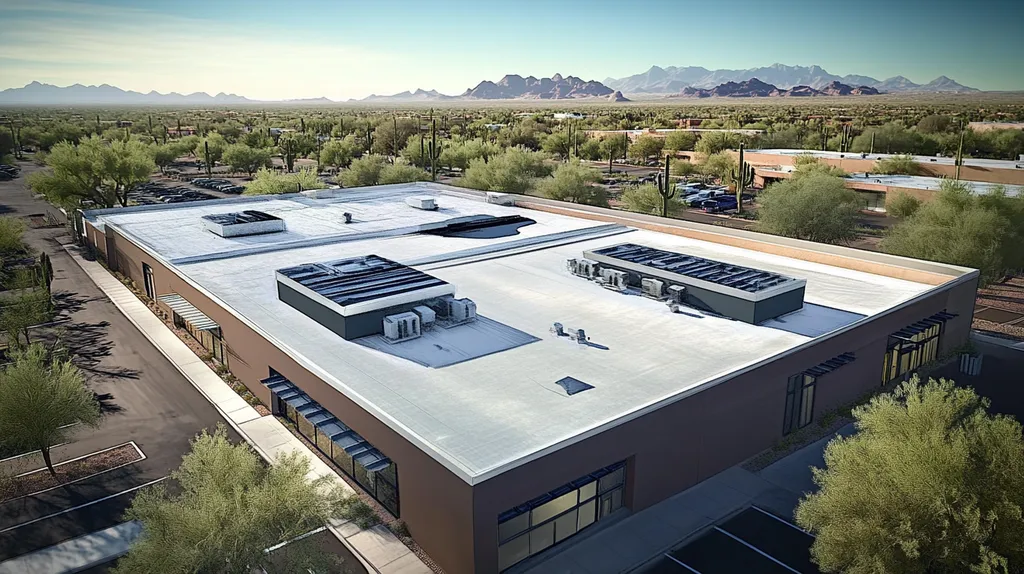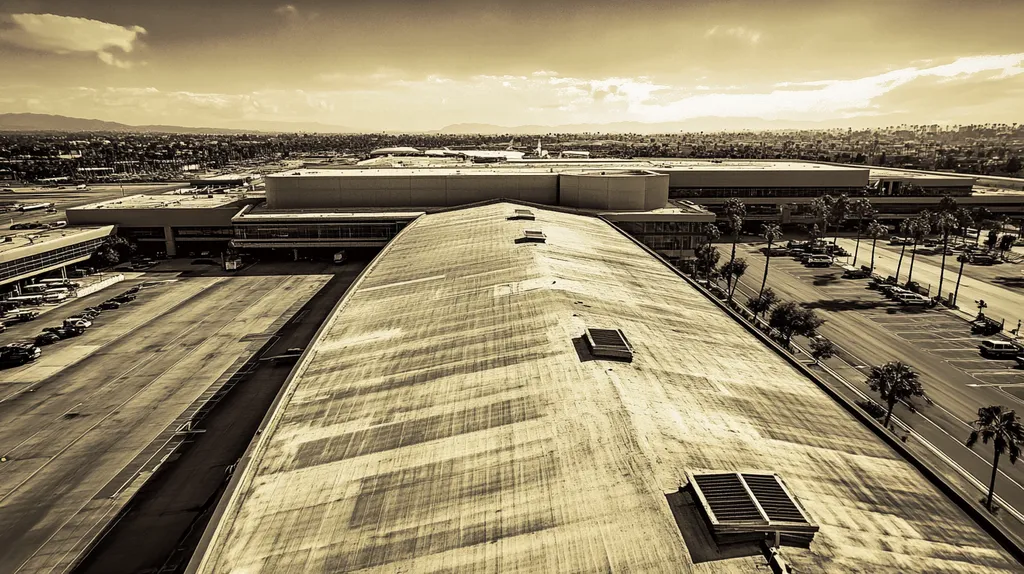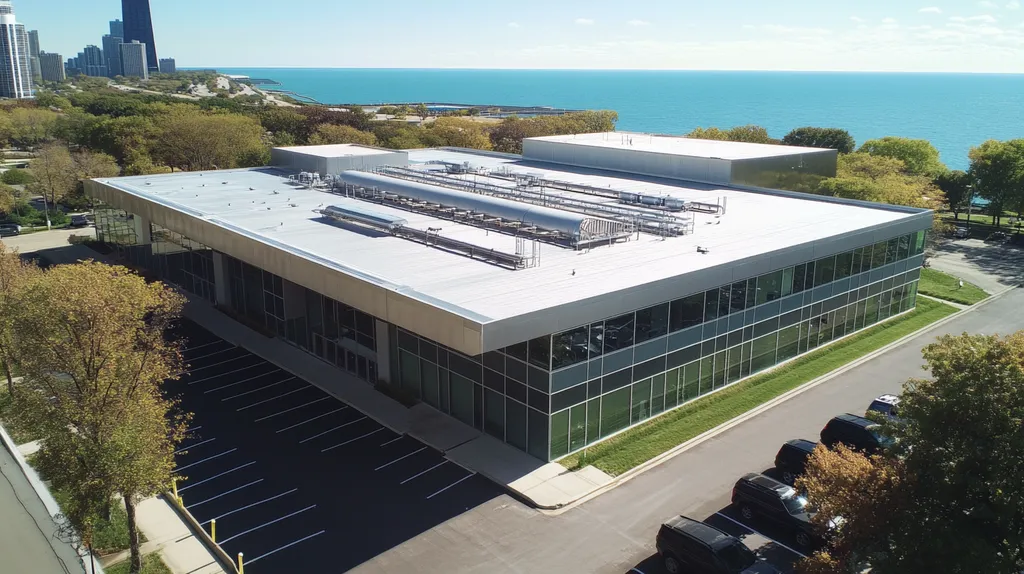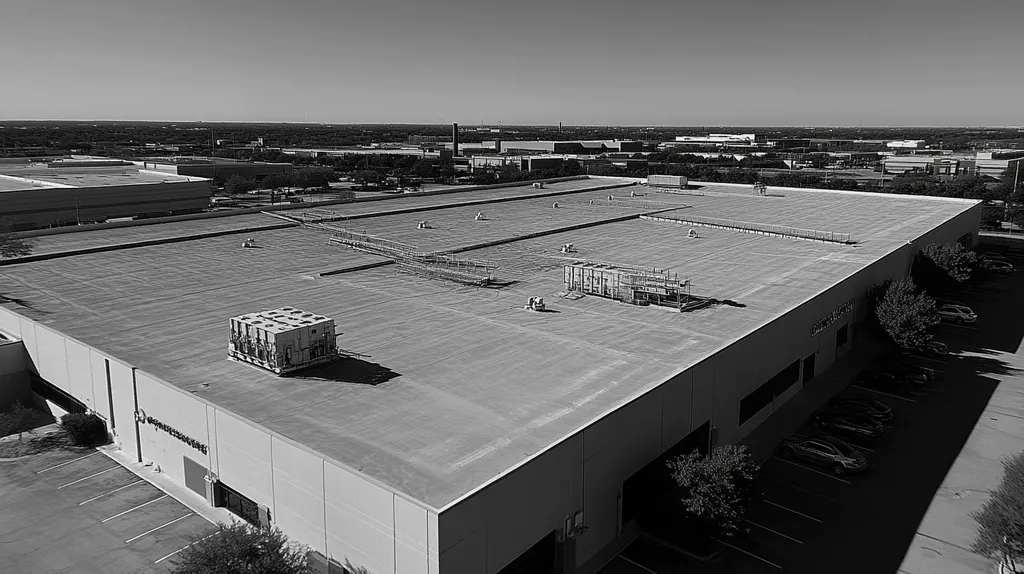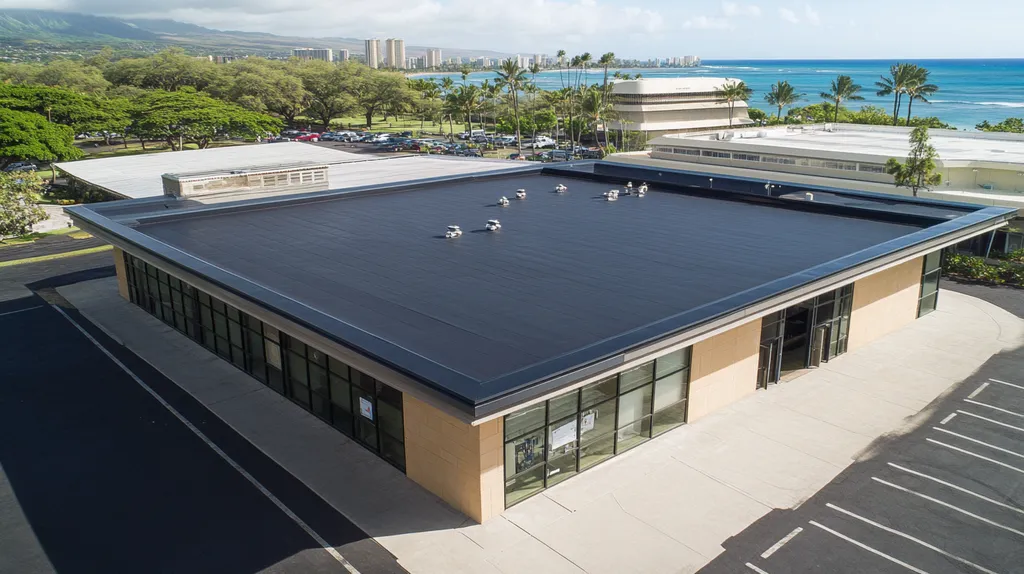Industrial roof coatings represent a critical $3.2 billion market, yet nearly one-third of warranty claims stem from adhesion failures that compromise structural integrity and safety.
Current testing processes for industrial roof adhesives consistently overlook crucial variables like environmental conditions and long-term performance, leading to premature coating failures that cost facility owners millions in repairs annually.
This analysis examines systemic flaws in established adhesive testing methods while exploring data-driven solutions that could revolutionize how the industry evaluates and ensures coating reliability.
SECTION 1: CURRENT PRACTICES
The effectiveness of industrial roof coatings relies significantly on adhesion testing methods. Poorly conducted tests can result in expensive failures that threaten the structural integrity of buildings and lead to inflated maintenance costs. Alarmingly, about 30% of warranty claims in the roofing industry stem from adhesion failures. For property owners and facility managers, grasping the nuances of current practices is vital for making well-informed roofing decisions that protect their investments.
Standard Adhesion Testing Methods
Adhesion testing generally employs several established methodologies, with ASTM D3359, known as the cross-cut tape test, and ASTM D4541, the pull-off test, being among the most common. The cross-cut tape test assesses a coating’s ability to endure mechanical stress, while the pull-off test determines the force needed to detach a small area of coating from its substrate.
Although these standardized tests provide a foundation for evaluating adhesion, they can lead to misleading conclusions in real-world conditions. Factors such as temperature and humidity, which directly impact adhesion, are frequently excluded from test environments. Coatings that pass these tests might still perform poorly in changing climates, leading to unexpected issues over time.
Moreover, many testing scenarios concentrate solely on the immediate strength of the adhesion without considering how aging and wear will affect long-term performance. This limited perspective could create an unwarranted sense of reliability, putting structures at risk of early failure.
While standardized adhesion tests serve as a helpful starting point, they don’t fully account for the complexities associated with real-world applications. Thus, revisiting and enhancing these testing methods is essential for boosting reliability in roofing systems.
Common Tools and Equipment Used
The tools and equipment utilized for adhesive testing are pivotal in achieving accurate results. Testers often employ handheld instruments like auto-scaling tape and pull-off testers to evaluate the quality of adhesion.
To ensure reliable outcomes, it is crucial that only high-quality materials, including specialized adhesives and laboratory-grade substrates, are used. These components should adhere to industry specifications, as any deviation can compromise test validity. An over-dependence on standard equipment might obscure underlying issues affecting adhesion.
Additionally, many testing tools fail to consider external factors like weather conditions and surface contaminants. Such oversights can result in test results that do not accurately represent the real-world performance of roof coatings.
It’s essential to regularly update testing tools to incorporate technological advancements. Without consistent upgrades and the use of modern techniques, property owners risk making decisions based on outdated and unreliable data.
Typical Preparation and Application Procedures
Preparation and application procedures are essential steps in adhesion testing and significantly influence the reliability of the results. Typically, surfaces require thorough cleaning and priming before any tests to ensure optimal contact between the coating and the substrate.
However, standard practices may not sufficiently address the diverse characteristics of various roofing materials and environmental factors. For instance, if surfaces are not properly cleaned, adhesion can fail even if the coating appears satisfactory during initial assessment.
Timing also plays a crucial role in determining the outcomes of adhesion tests. Environmental conditions, including humidity and temperature during application, can greatly impact adhesion quality, yet these elements are often uncontrolled during testing.
A lack of tailored guidance on preparation practices for specific roofing environments can lead to significant discrepancies between the results of tests and actual field performance. Neglecting to factor in these considerations may ultimately compromise the integrity of roofing systems.
In summary, while there are established preparation and application procedures, a renewed focus on adapting practices to real-world conditions is urgently needed to ensure better adhesion performance.
SECTION 2: SYSTEMIC ISSUES
The reliability of adhesive testing for industrial roof coatings is critical due to widespread inconsistencies that could lead to expensive failures. Such setbacks not only result in significant financial losses but can also disrupt business operations, costing property owners thousands of dollars. Given that large-scale roofs safeguard crucial infrastructure, understanding the systemic issues of inconsistent surface preparation, variability in curing times, and the absence of standardized interpretation criteria is essential for informed decision-making.
Inconsistent Surface Preparation
Surface preparation is a crucial step in adhesive testing, yet practices across the industry vary widely. Some contractors may neglect vital aspects like substrate cleanliness or moisture content. When surfaces are inadequately prepared, adhesives can fail to bond correctly, resulting in premature roofing failures.
The ramifications of inconsistent preparation can be severe. A single section that is improperly prepped may develop issues like blisters or peeling, triggering costly repairs. Sites that disregard best practices often face unexpected maintenance costs, diminishing both resources and trust in the roofing process.
The issue lies not only in individual practices but also in the lack of robust industry standards. Establishing clear guidelines for effective surface preparation could significantly reduce risks and enhance overall adhesion outcomes, enabling property owners to make more confident decisions regarding materials and contractors.
Ultimately, the industry must prioritize consistency in surface preparation to enhance the reliability of adhesive testing. Improved practices will help safeguard investments and ensure that coatings achieve the expected performance lifecycle.
Variability in Curing Times and Conditions
Curing times and conditions are pivotal to achieving optimal adhesive strength but often lack uniformity in industrial applications. Factors like temperature and humidity can dramatically influence the curing process, yet many installations fail to adjust their procedures accordingly.
This variability presents a significant risk. Adhesives applied in subpar conditions may take longer to cure, leading to weakened bonds. For example, a roof coated in high humidity may struggle with adhesion, resulting in costly repairs later.
In addition, differing curing requirements for various adhesives create confusion among contractors and facility managers. Without a standardized approach, the likelihood of errors increases, which can negatively impact the roofs’ longevity and performance.
To address this challenge, it is essential to establish clear guidelines regarding curing conditions and provide comprehensive training for application technicians. These efforts can enhance predictability and reliability in adhesive testing, leading to more durable roofing solutions.
Lack of Standardized Interpretation Criteria
The analysis of adhesive test results often leans heavily on subjective judgment, resulting in inconsistent outcomes across projects. Currently, there is no universally accepted method for evaluating adhesive bond effectiveness. This lack of definitive criteria can lead to miscommunication and varied interpretations among roofing professionals.
When assessments of bond strength differ widely, the decisions based on these results can have severe repercussions. A contractor might declare adhesion as acceptable, only for a follow-up inspection to reveal failures, raising serious quality control concerns.
Implementing a standardized framework for interpreting adhesive testing results would empower property owners and facility managers to make informed decisions. Clear benchmarks would help to minimize misunderstandings and yield more reliable roofing solutions.
In conclusion, establishing standardized interpretation criteria is crucial for the integrity of the roofing industry. Achieving consensus on these benchmarks will ultimately foster better product performance and enhance trust in the adhesives used in various roofing systems.
SECTION 3: MISSED OPPORTUNITIES
The current adhesive testing processes for industrial roof coatings leave critical gaps that can jeopardize the durability and performance of roofs. By overlooking essential aspects such as the interactions between primer and coatings, the industry risks adhesive failures that can lead to costly leaks and structural damage. As a result, property owners may face unexpected maintenance expenses due to the inadequacies of current practices in assessing real-world conditions. This section examines three significant missed opportunities in adhesive testing that necessitate industry improvement.
Overlooking Primer and Coating Interactions
The interactions between primers and coatings are vital for achieving long-lasting adhesion. Unfortunately, many testing protocols concentrate solely on individual materials, neglecting how they work together in real-world settings. This gap can create weak links in the roofing system, ultimately threatening its structural integrity.
For instance, if a primer has not been properly tested with a specific top coating, it may lead to inadequate adhesion. Reports indicate that nearly 30% of roofing failures can be traced back to this critical oversight.
Moreover, while certain combinations of primers and coatings are carefully engineered for optimal performance, they often remain untested together. This results in lost opportunities to verify strong adhesion, undermining the overall durability of roofing systems.
Lastly, a lack of thorough testing on primer and coating compatibility may leave building owners without recourse from manufacturers when issues emerge. Strengthening testing guidelines in these areas can mitigate risks and ultimately save significant costs in the future.
Neglecting Environmental Factors
Adhesive testing frequently disregards key environmental factors that can have severe long-term effects on adhesion. Conditions such as temperature fluctuations, humidity, and UV exposure are crucial in determining how well adhesives perform over time. When these variables are overlooked, the reliability of test results is compromised.
For example, an adhesive showing excellent performance in a controlled lab environment could fail under real-world exposure to the elements. Studies indicate that over 40% of roof coatings face decreased adhesion due to environmental stressors, underscoring the pressing need to incorporate these factors into testing protocols.
Additionally, different geographical locations experience unique weather patterns that can significantly influence roof performance. Adapting testing procedures to reflect local conditions can markedly enhance the reliability of adhesion, thereby extending the lifespan of the roofing system.
The industry cannot afford to overlook the importance of field simulations that replicate real-world environments. Capturing these factors will lead to improved adhesive testing, resulting in more reliable roofing solutions and fewer unexpected failures.
Ignoring Long-Term Adhesion Performance
Many current adhesive testing methods prioritize short-term performance, often at the expense of long-term durability. This limited focus can cause premature failures, resulting in costly repairs and operational disruptions for property owners.
Research shows that many adhesives gradually lose their effectiveness due to aging, thermal cycles, and moisture absorption. Without thorough long-term testing, manufacturers lack the data necessary to guarantee the durability of their products once installed.
Furthermore, property owners may be left relying on incomplete data when making roofing decisions, inadvertently setting the stage for larger issues down the road. By implementing comprehensive long-term performance testing, the industry can gain a better understanding of a product’s longevity and reliability.
Clearly, enhanced testing protocols need to incorporate long-term studies that reveal potential weaknesses. These insights will empower property owners to make informed choices that not only save money but also protect their investments over time.
SECTION 4: ROOT CAUSES
The effectiveness of adhesive testing for industrial roof coatings is critical to ensuring the longevity of roofing systems. Yet, current processes often fall short due to several fundamental issues. A combination of inadequate training, vague regulatory guidelines, and pressing cost and time constraints creates an environment where quality suffers. These root causes not only threaten the overall durability of installations but also expose property owners to potentially hefty repair costs down the line.
Inadequate Training and Expertise
The roofing industry grapples with a notable gap in necessary training and expertise related to adhesive testing. Many installers lack a comprehensive understanding of roofing materials and their interactions. Consequently, improper application or insufficient testing of adhesives can lead to weak bonds and a compromised roofing system.
This knowledge gap can trigger severe consequences, such as premature failures and expensive repairs. Property owners unaware of the best practices for adhesive usage put their roofing investments at risk. Initiatives aimed at educating personnel about the critical importance of adhesive testing are essential for fostering long-term industry success.
Moreover, manufacturers often fail to provide adequate training resources to contractors. Many workers are left to navigate the complexities of adhesive testing through trial and error instead of structured learning. This can easily lead to neglecting the meticulous attention to detail that effective adhesive testing demands.
Overall, bolstering training programs can enhance adhesive performance and extend roof lifespans. By prioritizing well-trained personnel, stakeholders can better mitigate risks associated with faulty installations.
Insufficient Regulatory Guidelines
A significant hurdle in adhesive testing arises from the absence of comprehensive regulatory guidelines. Existing regulations often lack clarity regarding the specific properties that adhesives must possess, leading to inconsistent applications across the industry. This discrepancy can leave property owners vulnerable to inferior installations.
Due to vague regulations, manufacturers have different protocols for adhesive testing, complicating efforts to ensure consistent quality. Consequently, property managers may unknowingly choose adhesives that do not meet necessary durability standards for their roofing systems.
This inconsistency can lead to early failures and unexpected maintenance costs. The consequences of flawed installations extend beyond mere financial losses; they also raise serious concerns about tenant safety and business continuity.
Enhancing regulatory frameworks for adhesive testing can create a more unified approach across the industry. By establishing clear, standard testing protocols, property owners gain confidence in their roofing systems, resulting in fewer failures and more reliable performance.
Cost and Time Constraints
Cost and time pressures frequently compromise the integrity of adhesive testing processes. Many property managers face significant pressure to reduce expenses while adhering to tight project timelines. In such high-stakes environments, thorough adhesive testing often falls low on the priority list.
Choosing faster, cheaper alternatives may yield short-term savings but can lead to long-term failures. Skipping critical testing can result in inadequate adhesive performance, ultimately shortening the lifespan of the roofing system. What initially seems like a minor cost-saving measure can escalate into significant repair expenses later.
Addressing financial and temporal constraints within the roofing industry can lead to improved installation quality. Investing the necessary time and resources in adhesive testing can prevent costly issues in the future, ensuring the durability and effectiveness of industrial roofing systems.
DATA DRIVEN EVIDENCE
The reliability of industrial roof coatings is at stake, with improper adhesion leading to costly damage and reduced functionality. Alarmingly, studies indicate that approximately 30% of roof failures can be traced back to insufficient adhesion. This section examines tangible case studies, statistical analyses, and comparative research to shed light on the critical shortcomings of conventional adhesive testing methods.
Case Studies of Adhesion Failures
A number of documented cases illustrate the harsh realities of adhesive failures in industrial roofing. In one instance, a manufacturing facility experienced severe leaks just two years after installation. Investigations revealed that environmental factors led to a weakening of the adhesive bond.
In another example, a distribution center’s adhesive sustained damage due to inadequate performance in thermal cycling, ultimately requiring a costly roof replacement within four years.
These cases emphasize the urgent need for improved testing protocols that mimic real-world conditions, addressing environmental and operational factors that frequently compromise adhesive performance.
Statistical Analysis of Test Results
A thorough review of adhesive test data reveals concerning trends. A recent meta-analysis covering various industrial coatings found that 40% of test samples did not meet established industry standards. Failures generally occurred under conditions designed to replicate real-world scenarios, such as extreme temperatures and humidity.
This discrepancy points to a troubling disconnect between laboratory findings and actual field performance. Notably, data indicates that winter months compound adhesion issues, with failure rates increasing by as much as 50% in colder climates.
Such insights highlight the necessity for revised testing standards that account for diverse environmental influences, ultimately reinforcing the need for adaptive practices in adhesive testing.
Comparative Studies of Different Coatings
Research comparing various roof coatings reveals significant differences in adhesion performance. For instance, studies indicate that certain polymer-based coatings demonstrate a 25% higher failure rate compared to traditional asphalt-based materials over a five-year period.
Conversely, fiber-reinforced coatings consistently outperform standard options in adhesion tests, particularly in abrasive environments. As the roofing industry increasingly shifts toward more sustainable options, these findings underscore the importance of rigorous, thorough testing methods across all new materials.
Understanding these performance discrepancies enables property owners to make informed choices that minimize the risk of adhesive failures, ensuring the longevity and effectiveness of their roofing systems.
SECTION 6: ALTERNATIVE SOLUTIONS
As the demand for dependable industrial roof coatings grows, property owners and facility managers must address the pressing threat of adhesion failures. Reliance on traditional adhesive testing processes often leads to inadequate assessments, risking costly repairs and operational disruptions. To defend against issues such as premature coating delamination or water infiltration, exploring promising alternative solutions is essential. This section examines advanced adhesion testing techniques, refined surface preparation methods, and integrated testing and monitoring systems designed to elevate overall roofing performance.
Advanced Adhesion Testing Techniques
Recent advances in adhesion testing techniques are transforming the industrial roofing landscape. Methods such as peel tests and shear tests provide more precise results that reveal the true bonding strength of coatings. Digital imaging technology can further amplify these analyses by quantifying adhesion failures at a microscopic level.
Additionally, many of these advanced techniques allow for on-site testing, significantly diminishing the waiting time for laboratory results. Immediate feedback enables real-time adjustments during application, ensuring that adhesion levels meet requirements before the process concludes. This proactive approach translates into fewer warranty claims and improved long-term performance.
The new testing equipment is also increasingly portable and user-friendly, simplifying adoption for facility managers without necessitating extensive training. Compliance with emerging industry standards becomes more achievable, actively protecting investments in roofing systems.
Ultimately, incorporating advanced adhesion testing techniques fosters a culture of quality and reliability, which is critical in today’s competitive marketplace.
Enhanced Surface Preparation Methods
Effective surface preparation is paramount for securing proper adhesion in industrial roof coatings. Subpar preparation often leads to failure due to contaminants like dust or residue. Enhanced surface preparation methods, including high-pressure washing and laser cleaning, ensure surfaces are as clean as possible.
For example, employing an abrasive blasting technique can efficiently eliminate coatings or contaminants that hinder bonding. This approach not only prepares the surface but also enhances its texture for better mechanical adhesion. Although property owners might incur higher initial costs for these thorough methods, the long-term savings manifest through reduced maintenance expenses.
Incorporating chemical primers during the surface preparation stage can optimize adhesion outcomes even further. These primers modify surface properties, allowing coatings to bond more effectively, thus providing significant reassurance against early failures.
In conclusion, prioritizing enhanced surface preparation techniques yields improved adhesion and substantially extends the lifespan of industrial roofing systems.
Integrated Testing and Monitoring Systems
Adopting integrated testing and monitoring systems presents a strategic approach for maintaining roofing systems. By embedding sensors within the roofing structure, facility managers can gather real-time data on temperature, moisture, and stress levels. Continuous monitoring can help identify potential adhesion issues before they escalate.
Data analytics platforms are capable of processing this real-time information, yielding actionable insights that preempt significant problems. For instance, a sudden spike in moisture levels can trigger an immediate inspection, potentially averting costly repairs.
Furthermore, integrating advanced materials that possess self-healing properties can further boost roofing resilience. These innovative materials can automatically respond to minor damages, promoting longevity and minimizing maintenance needs.
In summary, adopting integrated testing and monitoring systems offers a comprehensive solution, empowering facility managers to make informed decisions while ensuring optimal roof performance.
Looking Ahead
The $3.2 billion industrial roof coating market stands at a critical crossroads, with nearly one-third of warranty claims stemming from preventable adhesion failures.
Current testing protocols consistently fail to account for real-world conditions, primer interactions, and long-term performance factors, leading to premature coating failures that cost facility owners millions annually.
Without immediate industry-wide adoption of advanced testing techniques, enhanced surface preparation methods, and integrated monitoring systems, property owners will continue facing unnecessary risks and expenses.
The data clearly demonstrates that standardizing interpretation criteria, improving training protocols, and implementing comprehensive regulatory guidelines can dramatically reduce failure rates while extending roof lifespans.
The future of industrial roof coating reliability depends on abandoning outdated testing practices in favor of evidence-based solutions that protect both properties and investments.
FREQUENTLY ASKED QUESTIONS
Q. What are current adhesive testing methods for commercial roofs?
A. Current methods primarily include ASTM D3359, which tests mechanical stress endurance, and ASTM D4541, which assesses pull-off strength. While these tests establish a baseline, they often disregard real-world factors like temperature and humidity, which can impact overall effectiveness over time. An understanding of these nuances is essential for property owners to ensure their commercial roofing systems maintain integrity.
Q. How does surface preparation affect industrial roof adhesion?
A. Surface preparation plays a crucial role in ensuring reliable adhesion for industrial roofs. Inconsistent practices can lead to dirt and moisture issues that compromise the bond between the coating and substrate. Adhering to recognized preparation methods will help property managers avoid complications and costly repairs, thereby extending the roofing system’s lifespan.
Q. What environmental factors should be considered in adhesive testing?
A. It’s essential to consider factors like temperature changes, humidity, and UV exposure when testing adhesives. These environmental aspects critically influence how well an adhesive performs over time. By integrating these variables into testing protocols, property managers can obtain a more accurate understanding of long-term adhesion, leading to fewer failures in real-life scenarios.
Q. Why is standardized interpretation of adhesive tests important for commercial roofs?
A. Standardized interpretation of adhesive test results is crucial for ensuring consistency in quality across installations. Without clear benchmarks, evaluations can vary significantly between professionals, leading to unreliable outcomes and potential failures. Establishing universal criteria allows property owners to make informed decisions about materials, ultimately safeguarding their commercial roofing investments.
Q. What are some advanced adhesive testing techniques available?
A. Advanced techniques such as peel and shear tests offer more accurate insights into adhesion capabilities. Employing digital imaging can further enhance analysis by visualizing microscopic failures within the bond. These methods allow for immediate onsite testing and adjustments during application, making them invaluable for maintaining high-quality roofing standards.
Q. How does inadequate training affect adhesive testing outcomes?
A. Inadequate training leads to improper application techniques and insufficient understanding of materials. This can result in weak adhesive bonds and increased failure rates in roofing systems. By investing in comprehensive training programs for staff, property owners can significantly improve adhesive performance and reduce the likelihood of costly repairs over time.
Q. What are potential future solutions for adhesive testing in roofing?
A. Future solutions may include integrated testing systems with real-time monitoring capabilities, allowing for ongoing evaluation of adhesive performance. Additionally, employing innovative materials with self-healing properties can mitigate adhesion failures before they escalate. These advancements will enable property managers to proactively maintain structural integrity and optimize long-term performance.


